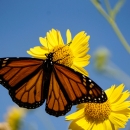The monarch, Danaus plexippus, is a species of butterfly globally distributed throughout 90 countries, islands, and island groups. These butterflies are well known for their phenomenal long-distance migration in the North American populations. Descendants of these migratory monarch populations expanded from North America to other areas of the world where milkweed (their larval host plant) was already present or introduced. With the year-round presence of milkweed and suitable temperatures, many of these global monarch populations no longer migrate.
Two North American populations, the migratory populations located east and west of the Rocky Mountains, have been monitored at their respective overwintering sites in Mexico and California since the mid-1990s. While these populations fluctuate year-to-year with environmental conditions, these census data indicate long-term declines in the population abundance at the overwintering sites in both populations (Figure E1). These declining trends led to the petition of the U.S. Fish and Wildlife Service to list the monarch butterfly for protection under the Endangered Species Act of 1973, as amended.
Using the best available scientific information about monarchs in North America and worldwide, we conducted a species status assessment (SSA). This report summarizes the results of our SSA. We delineated the historical number and distribution of monarch populations, assessed the status and health of the currently extant populations, identified the key drivers of their health, forecasted the likely future change in these drivers and monarch population responses to these changes, and evaluated the consequences of the population responses to monarch viability. Specifically, we evaluated the ability of the monarch to withstand environmental stochasticity (resiliency), catastrophes (redundancy), and novel changes in its biological and physical environment (representation).
We delineated 31 historical populations; of these, 27 are extant and 4 have unknown status. Outside of the 2 migratory North American populations, the health of the remaining 29 populations is undeterminable due to limited information available on population trends and stressors. However, at least 15 of these populations are at risk of extinction due to climate change climate change
Climate change includes both global warming driven by human-induced emissions of greenhouse gases and the resulting large-scale shifts in weather patterns. Though there have been previous periods of climatic change, since the mid-20th century humans have had an unprecedented impact on Earth's climate system and caused change on a global scale.
Learn more about climate change related sea level rise or unsuitably high temperatures. The results for the two migratory North American populations show that both are facing declining numbers and overall health.
The primary drivers affecting the health of the two North American migratory populations are primarily: loss and degradation of habitat (from conversion of grasslands to agriculture, widespread use of herbicides, logging/thinning at overwintering sites in Mexico, senescence and incompatible management of overwintering sites in California, urban development, and drought), continued exposure to insecticides, and effects of climate change. Relative to the recent past, both the eastern and western North American populations have lower abundances and declining population growth rates. Using the best available science, we estimated the probability of the population abundance reaching the point at which extinction is inevitable (pE) for each population given their current abundance and growth rate, as well as under projected future conditions. The pE for the western population is high (60% to 68% chance within 10 years, reaching 99% by year 60) under current conditions and increases under projected future conditions. For the eastern population, the pE in 60 years under current conditions ranges from 48% to 69%, and under the projected future conditions, it ranges from 56% to 74%. The range in the estimates represents the best and worst plausible future state conditions of the primary drivers.
Additionally, at the current and projected low population numbers, both the eastern and western populations are more vulnerable to catastrophic events (e.g., extreme storms at the overwintering habitat) than in the past. These risks, however, are not captured in the pE estimates. Similarly, we found that under different climate change scenarios, the number of days and the area in which monarchs will be exposed to unsuitably high temperatures will increase markedly. We were unable to incorporate the effects of high daily temperatures into the extinction analyses, and thus, these risks as well are not fully captured in the pE estimates.
The extinction of either the western or eastern North American migratory population would increase the risk of losing the North American migratory phenomenon, as its persistence would depend solely upon the continued survival of a single population. Moreover, loss of either population would impair the species’ ability to adapt into the future. The North American populations are unique in their long-distance migratory ability, and they represent unique sources of genetic and ecological diversity. Further, these two populations represent the historical and current core of the species and the ancestral lineage of the species. The eastern North American population is by far the largest of all populations (both in number of individuals and range size), and the western North American population encompasses as much as 30% of the geographic range occupied by monarch butterflies in North America. Accordingly, loss of these two ACUs would reduce monarch diversity, rendering the species less able to adapt to novel changes in its environment now and in the future and thereby increasing the extinction risk of the monarch. The chance of both populations persisting above the extinction threshold over the next 10 years is 27% to 33% (under future conditions) and drops under 10% within 30 years. Based on this information and other analyses of influences included in this SSA, monarch viability is declining and is projected to continue declining over the next 60 years.

